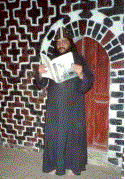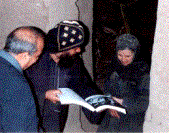A Personal View
by William Sommers
Sometimes reading a book can change your life. Bill Sommers during his assignments with the Agency for International Development always dug deeply into the history and culture of the countries where he was assigned. While in Egypt he bought a study of the village of Mari Girgis written by a French anthropologist and sociologist which also contained native songs and verses. Inspired by the book, Bill visited and re-visited Mari Girgis and found in his meetings with its villagers and chief priest “a rapport and understanding of life and its meaning” that he has never forgotten. Now, almost 20 years later, he has begun putting into a poetic format translations of songs and verses from the book. Two are printed below. Let’s slow down a bit, and take a few moments to read and enjoy them. –Assoc Ed.
Egypt is a country over which the storms of history have blown, again and again, until it has become a repository of both Eastern and Western history. One of the oldest civilizations via the Pharaonic ages that covered nearly 5000 years of recorded history, Egypt also was ruled by Greeks, Romans, Persians, Ottoman Turks, Mamelukes, French, British, and finally by its own people – after the rise of Nasser. Each of those eras of dominance – long and short – has its monuments and, appropriately, its ruins throughout the land and in countless museums as well as fiercely held artifacts scattered throughout the whole of the known world!

Moreover, its influence on religion – particularly in the West – is no less profound. Alexander the Great made himself an Egyptian God in the western desert shrine of Siwa, while his successors, the Ptolemys, ruled for over 300 years, descendents of Alexander but also pharaohs who built and rebuilt many of Egypt’s ancient temples and monuments. The Romans, searching for truth in their own religious muddle, promoted the worship of Osiris and Isis to the point where these sects grew and became a distinct part of the Roman Empire. Even the popes of Rome gathered the best Egyptian obelisks and built museums to house their gathering of Egyptian artifacts. And the West developed the idea of Masonic virtue based on the pyramids, while even today the U.S. dollar renews the Egyptian religious influence with the pyramid and its all seeing eye, the backside of the U.S. great seal. Actually, the eye in the Pharaonic tradition was the eye of the dead ruler who, using his everlasting soul – ba – could peek out through his tomb to see how things were going!
One of the great influences that sprouted from Egypt was the rise of Christianity and its religious organizations like the Catholic Church, the Orthodox Churches and, eventually as break-aways, the many Protestant visions, including the various Churches of England. The Nicene Creed, for example, was hammered out in the Turkish city of Nicea, now known as Isnik, and was basically a resolution imposed by Constantine the Great on the bitter theological factions originating in Alexandria, Egypt.
Which brings us to the one surviving people of Pharaonic Egypt, the Copts, who make up the current Orthodox Egyptian Christianity with their own pope, their own history, and their own theology, art, language, and view of life. This church is one of the oldest in Christendom. Its tradition is based on St. Mark, who preached in Alexandria in the first century AD; the Copts believe that St. Mark heads the list of patriarchs of Alexandria and that the current Pope Shenda III is his 117th successor. Thus they believe themselves to be the oldest carrier of the Christian religion, while they may also hold the distinction of being the actual descendents of the Egyptians of the Pharaohs. In addition the Copts represent the last stage of the ancient Egyptian language, as represented in the script and liturgy used in their churches.
The word Copt derives from the Greek Aigyptios (Egyptian) via Coptic (Kyptaio) as well as the Arabic Qibti.

One aspect of this tradition affected my own stay in Egypt during the early 1990s. Through the kindness of an Islamic Egyptian friend I received a copy of a marvelous study of the village of Mari Girgis, located in Upper Egypt, a bit south of the famous ruins of Karnak. The study was done by a French genius of local anthropology and sociology, Nessiim Henry Henin. He spent two years in this small, poverty stricken Coptic village detailing nearly every aspect of its life, resulting in a monumental book (442 pages), published in 1988. It is an unbelievable collation of sketches, pictures, descriptions, and detailed archives of work, life, religion, and songs/poetry that is overwhelming in all aspects. The book is in French without translation; it is still available through Amazon, Albris, and other on-line booksellers. Mari Girgis is the Arabian version of the vaunted St. George who slew the mighty dragon – a tale which is reproduced in nearly every country that I lived in or visited.

I loved the book, though my French capacity did not reveal the detail except in the drawings and the pictures. But I was enthused enough to make two visits to that village. The first one was an offshoot of a visit to the whole area, with particular emphasis on the larger cities of Sohag and Akimm, which had projects under our U.S. development program. But just before I left Egypt I re-visited Mari Girgis and brought a copy of the book itself to the village, a copy that the villagers had never seen before though many had fond memories of the time spent with Monsieur Henin. I gave the copy to the chief priest of the village and he was so pleased to have it that he took me door to door to meet the villagers who had participated in the study. The high point was the visit with two of the three farmers of whom Msr. Henin had taken an extraordinary picture, returning from the fields with fresh picked vegetables. They were so happy to see themselves that, at my request, they autographed the picture with the help of the chief priest in writing their names. I had a sit-down lunch with many of the villagers and through my interpreter found a rapport and understanding of life and its meaning that I have never forgotten.
When I returned to Cairo and before I left my post, I arranged to have the collection of native songs and verses which Msr. Henin had re-printed in both Arabic and French, translated into English. I have begun – though belatedly – to put them into poetic format so that they would be appreciated and understood. Below are two of the poems that I have finished. They are rewritten, based on an English-French translation from the Arabic version of Songs of the Village of Mari Girgus (St. George).
The Fisher’s Lament
I once was a fisherman
throwing the net from my hand
into the Nile’s swirling tide:
more often than not
I drew in only a mud-filled mesh.Out of need I prayed:
I am your slave, O God,
When the tree of humility leaned
I made it straight.But these times disturb me,
My sorrow makes me sick;
O caravan people lead your camels
to me and I will abandon
this motion-less life of nothing.I turn in my hard sleep,
I dream in the wet sand and hear a voice:
“Such is the will of God, Fisherman,
Neither you nor I can do anything.”My prayers bleed from my eyes
and mix with the Nile’s
muddy, empty waters,
swirling out of sight.
The Lesson of Chance
I spread my bed, sleeping under a leaning wall.
My friend found me sick under this wall.
When we tried to straighten it to the right,
it would not be guided but leaned to the left.
I grew weary and my sickness grew as well.My friend went to get some medicine
to help me gain strength against the wall.
He found it, brought it to me
but, alas, under the punishing sun,
it had melted in the box!My friend wept because
he thought he had failed;
but I learned a lesson:
What can medicine do for those
who live under the shifting wall of chance?

William Sommers worked as a municipal administrator for many years in the United States and worked overseas advising on various local government development programs He and his wife, Joan, spent two years in Egypt from 1990-92, where they became involved with Mari Girgis and the Copts. They also lived and worked in Thailand, Philippines, Indonesia, Vietnam, Poland and Hungary. Sommers’ last overseas assignment was in Bosnia. They now live in North Carolina where Joan has continued her painting and William has continued writing and working on improvements in aspects of the local county government.
